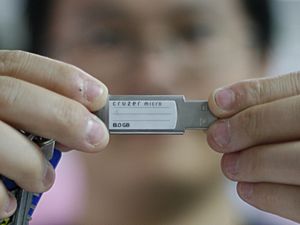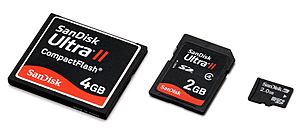Sneakernet facts for kids


Sneakernet is a fun, informal name for moving digital information by hand. Instead of sending files over the Internet or a computer network, you physically carry them on things like USB flash drives, external hard drives, or memory cards. The name "sneakernet" comes from the idea of walking in your sneakers to deliver the data!
Contents
What is Sneakernet and Why Use It?
Sneakernet is used all over the world for different reasons. It's like a special delivery service for digital files.
Why People Use Sneakernet
People use sneakernet when:
- No Internet or Slow Internet: Some places don't have internet, or it's very slow. Sneakernet helps them get information.
- Sharing Big Files: It can be faster to carry a huge file on a hard drive than to upload it online. Imagine trying to send a movie over a slow internet connection!
- High Security: For very secret information, physically carrying the data can be safer. It's harder for hackers to steal files that are not on a network.
- Computers Not Connected: Sometimes, computers are not linked to any network. Sneakernet is the only way to move files between them.
How Sneakernet Works
You simply copy files onto a portable storage device. Then, you carry that device to another computer and copy the files there. Common tools for sneakernet include:
- USB flash drives (small and easy to carry)
- External hard drives (can hold huge amounts of data)
- Memory cards (used in cameras and phones)
Even the United States Postal Service can be part of a sneakernet! They have a "Media Mail" service for sending things like compact discs. If you send a very large hard drive full of data, it can sometimes be faster and cheaper than sending the same data over the internet, especially for long distances.
Sneakernet Around the World
Many places use sneakernet for different needs. Here are some examples:
Afghanistan
In Afghanistan, people called "computer kars" share internet content by hand. They have huge collections of movies, music, apps, and updates. They carry these files on USB drives to customers. This helps people get content when internet access is limited.
Australia
Back in 1983, when Australia first joined a computer network called Usenet, they received information on tapes. These tapes were sent from the United States to a university in Sydney. From there, the data was shared with many other computers across the country.
Bhutan
The Rigsum Sherig Collection project in Bhutan uses sneakernet to bring learning materials to schools. Many schools have computers but no internet. Teachers carry external hard disks with free educational software, like Khan Academy, to these schools. This helps students learn even without online access.
Cuba
In Cuba, there's something called El Paquete Semanal (The Weekly Package). It's a huge collection of media, about 1 terabyte (1,000 gigabytes) of data! This package is shared every week using portable hard drives and USB sticks.
North Korea
People who disagree with the government in North Korea sometimes secretly bring in flash drives. These drives are filled with movies and TV shows from other countries.
Pakistan
After the raid on Osama bin Laden's compound in Pakistan in 2011, it was found that he used USB drives to store his emails. A messenger would then take these drives to an internet cafe nearby to send the emails. This was a way to communicate without being directly online.
South Africa
In 2009, a company in South Africa had a race between a messenger pigeon and an internet connection. The pigeon carried 4 gigabytes of data on a USB flash drive for about 60 miles. The pigeon won! It arrived in just over an hour, and it took another hour to copy the data. The internet connection only transferred a small part of the data in the same time. This showed how fast sneakernet can be for large files.
United States
Even big companies like Google and Oracle use sneakernet for huge amounts of data.
- Google: They have used sneakernet to move massive datasets, like 120 TB of data from the Hubble Space Telescope. If you use Google Cloud, you can send your data to them on physical devices.
- Oracle: They offer a Data Transfer Service where customers can send their data on physical drives to Oracle Cloud.
- SETI@home: This project, which searches for alien life, used sneakernet. Data from a radio telescope was stored on magnetic tapes and then shipped to California for analysis.
- AWS Snowball: Amazon Web Services (AWS) offers devices like AWS Snowball, a 50-pound box that holds 50 TB of data, to help customers move large amounts of information to their cloud storage. They even have a truck called AWS Snowmobile that can carry 100 petabytes (a huge amount!) of data.
Sneakernet in Stories
The idea of sneakernet has appeared in books and movies:
- In the movie Minority Report, people move data between computers using flat storage devices.
- The book Going Postal by Terry Pratchett has a race between a horse-drawn mail coach and a "Clacks" (a type of semaphore line) to see which can send a book's content faster.
- In Spook Country by William Gibson, iPods are used to secretly move information.
- In Cory Doctorow's book Little Brother, the main character uses "sneakernet" to describe how he and his friends share special software.
Similar Ideas
- IP over Avian Carriers: This is a funny, joke idea about sending internet messages using homing pigeons. It shows how people think about unusual ways to transfer data.
Images for kids
-
Compact cassettes were used to move data between ZX Spectrum computers in the 1980s.
- Air gap (networking)
- Darknet
- Data Mule
- IP over Avian Carriers
- Jargon File
- Meatspace
- Pod slurping
- Sideloading
- Twilight (warez)
- USB dead drop
See also
 In Spanish: Sneakernet para niños
In Spanish: Sneakernet para niños


